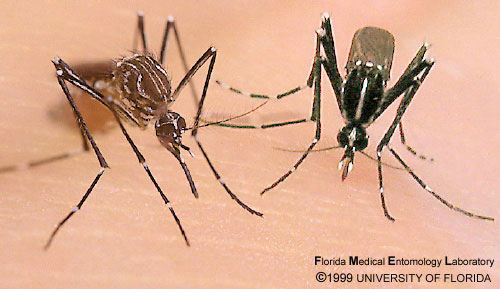We already heard substantial information about Zika virus, which usually comprises of basic knowledge about, but what else do we need to know with regards to this disease? By this time, we should be bombarding ourselves with updates that would equip us in becoming effective. The rate of its prevalence may not be as fast as other diseases. However, we must not underestimate these figures for it could surprise us a few weeks or months from now.

Here are additional information and updates that may bring a better understanding of Zika Virus.
1. There are two culprits for spreading Zika Virus: Aedes aegypti and Aedes albopictus

Aedes aegypti is a well-known vector for yellow fever virus, dengue virus and chikungunya virus, while Aedes albopictus is a known vector of dirofilariasis, chikungunya virus, and dengue virus. Though these vectors have common denominators, they originated in different areas. Aedes aegypti is known to originate from Africa that eventually spread in other tropical and subtropical parts of the world. Shipping activities and global trade facilitated the spread of this disease. This specie was identified to have a high vectorial capacity for viruses such as yellow fever virus, dengue virus, zika virus, and chikungunya virus.
On the other hand, Aedes albopictus is known to originate from Asia and eventually spread through the same means. But unlike, Aedes aegypti, albopictus can adapt in broader temperature range as well as cooler temperature, allowing them to persist in more temperate climates. In addition, this specie of mosquito lives in close proximity to people, but not as close as aegypti.
2. The distribution of Aedes aegytpi and Aedes albopictus greatly varies in the United States.

Based on this estimated distribution, it can be noted that Aedes albopictus more prevalent in the United States as compared to aegypti. This could be due to the fact that this specie can tolerate wide range of temperatures allowing them to adapt and survive in different locations.
| Aedes egypti | Aedes albopictus |
| Crete, Cyprus, France (incl. Corsica), Greece, Israel, Italy, Portugal, Southern Russia, Sardinia, Spain, Syria, Turkey and the former Yugoslavia in Europe and the Middle East and Algeria, Egypt, Libya, Morocco and Tunisia in North Africa. | Europe: Albania, Belgium (not established), Bosnia & Herzegovina, Bulgaria, Croatia, Czech Republic (not established), France (including Corsica), Germany (not established), Greece, Italy (including Sardinia and Sicily), Malta, Monaco, Montenegro, the Netherlands (not established), San Marino, Serbia, Slovenia, Spain, Switzerland, Turkey and Vatican City.
Middle East: Israel, Lebanon, Syria. Asia & Australia: Australia, Japan, New Zealand (not established), numerous Pacific Ocean and Indian Ocean islands and southern Asia. North, Central America & Caribbean: arbados (not established), Cayman Islands, Costa Rica, Cuba, Dominican Republic, El Salvador, Guatemala, Honduras, Mexico, Nicaragua, Panama, Trinidad (not established). South America: Argentina, Bolivia (not established), Brazil, Colombia, Paraguay, Uruguay, Venezuela.
|
Source: European Centre for Disease Prevention and Control.
3. Transmission of Zika Virus is not only limited to Mosquito Bite.
Apparently, Zika virus is not like Dengue virus which can only be transmitted by an infected mosquito by biting other people. According to CDC, these viruses can be transmitted in 4 different means:
- Mosquito bite: Aedes aegypti and albopictus are the only species that carries the virus. These mosquitos are known to aggressively bite during daytime as compared to night.
- Mother to child: A mother can pass the virus to their child once they got bitten by an infected mosquito during pregnancy. This is regardless of which stage of pregnancy they got infected. However, breastfeeding an uninfected child by a recently infected mother, would not cause transmission of the virus. Therefore, infants are not compromised of getting the nutrients which can only be found in breastmilk, especially the colostrum.
- Sexual contact: Zika virus is like a sexually transmitted disease for it could also be transmitted through sexual contact. This was actually proven! In fact, the virus was observed to stay longer in semen than in our blood.
- Blood transfusion: Although this hasn’t been strongly proven as of February 1, 2016, there were cases of blood transfusion which may have caused the French Polynesian breakout. This assumption is because of the test result collated, in which 2.8% of the donors were tested positive.
4. What is the difference of Congenital from Perinatal transmission of Zika virus?
Intrauterine transmission, also known as congenital transmission, is when a pregnant mother was infected by the virus during pregnancy (but at least more than 2 weeks prior delivery).
Perinatal transmission on the other hand is when a mother got infected by the virus within 2 weeks prior delivery. This type of transmission, the child has a great likelihood of developing symptoms such as fever, joint pain, maculopapular rash, and conjunctivitis.
5. What is Microcephaly?
Microcephaly is a condition in which the child’s head is significantly smaller than the head of other children of the same age and sex. However, the size is not the only concern of this condition, but also the impact on their development. According to Mayo Clinic, the child may experience developmental delays, particularly in movement and speech. In addition, there could also be a possibility that they may have difficulties with balance and coordination. Other complications of this condition are seizures, mental retardation, dwarfism, and facial distortions.
6. How is Zika Virus different from Dengue Virus, Chikungunya, and Yellow Fever?
To be honest, they have more similarities than differences, which is why it is very challenging to see how they differs thru our naked eyes. But to help us see their discrepancies, I created a simple chart that could guide us of their similarities and differences.
| Zika | Dengue | Chikungunya | Yellow Fever | |
| Vector | Aedes aegypti and Aedes albopictus | Aedes aegypti and Aedes albopictus | Aedes aegypti and Aedes albopictus | Aedes aegypti and Aedes albopictus |
| Transmission | Mosquito bite
Mother to child Sexual contact |
Mosquito bite | Mosquito bite | Mosquito bite |
| Symptoms | Mild fever, rash, joint pain and conjunctivitis | High grade fever, joint and muscle pain, headache, rash, pain behind eyes. | Severe joint pain and acute onset fever | Fever, muscle and joint pain, rashes, headache, vomiting, jaundice, and loss of appetite |
| Manifestation of Symptoms | 3 to 7 days | 3 to 7 days | 3 to 7 days | 3 to 4 days |
| Complications | Microcephaly
Guillain-Barré syndrome |
Internal hemorrhage, if not managed well, it could be fatal. | Eye, neurological and heart complications | Liver failure, kidney failure, jaundice |
| Treatment | N0 TREATMENT/ Supportive | N0 TREATMENT/ Supportive | N0 TREATMENT/ Supportive | N0 TREATMENT/ Supportive |
Looking at this chart, it appears that there is a stronger similarity, instead of differences, among these viral diseases. Though it may be challenging to determine its differences, the easiest way could be how severe the symptoms are. As compared to these viral diseases, Zika has one of the mildest manifestations. However, the complications and transmission is wider as compared to the other three.
7. What are the Best Preventive Measures for Zika Virus?
The precautionary measures for this virus would likely be the same for Yellow fever, Chikungunya, and Dengue. But since Zika Virus has more means of transmission, it would also best to add these preventive measures on your list.
- Limit traveling, particularly on countries in which the presence of Zika virus was identified.
- Aside from covering the majority of the body with clothes, it would also be better to treat your clothes, and even gears, with permethrin. It was reported that even after multiple washes and usages, permethrin is still able to maintain its protection. Though this can’t be used directly to our skin.
- Use condoms to avoid transmission of the virus from a male sex partner.
- If planning to get pregnant, it would be suggested to delay it for a couple of years is possible, especially if your area is reported to be one of the infected areas.
8. What is the Current Statistics about this Virus?
According to CDC, as of March 16, 2016, Zika virus disease and Zika virus, congenital infection is now considered to be nationally notifiable conditions. The prevalence of this disease is still growing. In the United States, about 258 were already reported. From this figure, 18 of them are pregnant women and 6 of them got the virus thru sexual contact. In U.S Territories, the numbers are higher. There were 283 locally acquired cases and 3 travel-associated cases. From 283 cases, 35 of whom are pregnant women.
In the Philippines, the number of people infected by Zika virus has not been defined yet.
But according to the Department of Health (DOH), an American woman who had a vacation in the country, was now tested positive when she came back to the United States.
DOH expound that the Zika virus is no longer new to us because they have already documented one case in Cebu City in 2012. After this, there were no other cases reported. Thus, Health Secretary Janette Garin advised that we shouldn’t panic for this is not considered to be an epidemic in the country.
An overflowing treatment is nothing to handful prevention. This is a fact that most of us often marginalized, merely because we don’t feel any symptoms yet. But this mindset sometimes leads us to actually developing the disease and even suffering from its complications. Though the Zika virus is not yet as prevalent as it is Brazil or United States, it shouldn’t be our excuse in becoming less cognizant of our surroundings and actions. It is imperative to stress on the preventive measures and make more people become aware of its implications so that we know how to better manage this virus. Again, Zika virus is not merely the same with Dengue, Yellow fever, and Chikungunya. Its symptoms may be less detrimental but its long-term effect is more aggravating.
References
- CDC. (2016). Zika Virus: Transmission and risks. CDC. Retrieved March 17, 2016 from http://www.cdc.gov/zika/transmission/index.html.
- CDC. (2016). Zika virus disease in the United States, 2015–2016. CDC. Retrieved March 17, 2016 from http://www.cdc.gov/zika/geo/united-states.html
- CDC. (2016). Zika virus: For pregnant women. CDC. Retrieved March 17, 2016 http://www.cdc.gov/zika/pregnancy/index.html.
- European Center for Disease Prevention and Control (2016). Aedes aegypti. European Center for Disease Prevention and Control. Retrieved March 17, 2016 http://ecdc.europa.eu/en/healthtopics/vectors/mosquitoes/Pages/aedes-aegypti.aspx
- Jaymalin, M. (2016). US woman gets Zika after Philippine visit. Phil Star. Retrieved March 17,2016 from http://www.philstar.com/headlines/2016/03/07/1560398/us-woman-gets-zika-after-philippine-visit
- Sutter-Yuba Vector Control District. (2016). Chikungunya, Dengue Fever, Yellow Fever and Zika. Sutter-Yuba Vector Control District. Retrieved March 17, 2016 http://www.sutter-yubamvcd.org/chikungunya-dengue-fever-yellow-fever-and-zika.








